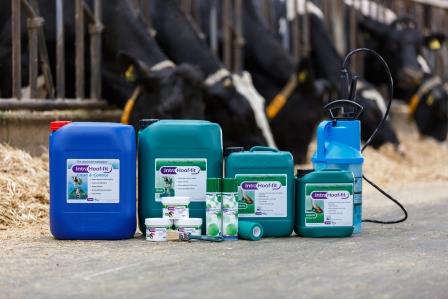Lameness is a very significant problem in many dairy herds. The cost of treating lame cows may appear to be the biggest economic cost of lameness. However, it is often quite negligible in the overall scheme of things.
Lameness is associated with a decrease in milk production, impaired reproductive performance and can increase the probability of a cow being culled.
Economic loss due to hoof ailments is often underestimated. The financial damage can range from €100 up to over €300 / lame cow.
Factors that have an impact on dairy cow lameness include: housing; cubicle design and size; adequate number of cubicles; damaged or poorly-fitted slats; poor farm road surfaces; nutrition; hygiene; slurry; high milk yield; breed; and stage of lactation/pregnancy. Preventative strategies include: hoof pairing; use of foot baths; isolation; and treatment of lame cows.
The losses in lameness are attributed to the fact that lame cattle eat less, are in pain, lie more and lose weight quickly. These factors usually combine to result in reduced milk production.
The additional risk of nutritional deficiency makes lame cattle more susceptible to other infections and fertility problems.
Hoof diseases are the biggest problem
Lameness treatment involves: hoof trimming; treating wounds and infections; and caring for the lame animal. By intervening early and properly animals will recover faster.
Infectious causes of lameness include: digital dermatitis (DD), also called mortellaro; foul in the foot (tyloma); and foot rot (interdigital dermatitis). Non-infectious hoof diseases include laminitis and sole ulcers. These conditions are extremely painful.
Prevention = Getting the success factors right
There are four success factors that can aid excellent hoof growth. These are outlined below.
1. Maintain optimum hoof quality: Shape and quality of horn
- Ensure high-quality feed and good feed intake. Be aware of the risk periods, which are generally before, during and after calving;
- Lift and examine hooves at least three times a year and trim – if necessary – to maintain correct hoof shape;
- Use footbaths as much and as often as necessary. Keep replenished as needed;
- Breed for hoof health;
- Keep hooves dry as much as possible.
2. Ensure minimal stress on hooves
- Cows need to lie down for as long as 12-15 hours per day. Spacious, dry and soft lying places ensure maximum lying time. Ensure cubicles are sufficient in number and of adequate size;
- The shed should be spacious enough to allow good cow flow and avoid pushing;
- Ensure floor surface is even with good grip. Ensure slats are properly fitted, with no excessively wide gaps and replace damaged slats;
- Manage high-risk locations (e.g turning points or tracks) and high-risk times – such as milking – so that cows are not crowded or pushed.
3. Keep cows’ environment welfare friendly
- Cow accommodation should be clean and dry;
- Cows constantly standing in slurry cannot avoid lameness. Keep slats, collection yards and roadways as clean as possible.
4. Intervene effectively at the first signs of lameness
- Make sure all farm workers detect and identify hoof problems at an early stage. Routine checks allow sufficient time for early treatment;
- Treat hoof problems quickly and effectively. Treat each cow individually;
- Get your vet for severe lameness and use a trained hoof pairing expert for herd lameness prevention if unable to do this yourself.
Hoof hygiene for today and tomorrow
To help farmers maintain optimal hoof health, Intracare – a leading Dutch provider of sustainable solutions – has developed Intra Hoof-fit Clean & Control.
This environmentally-safe and antibiotic-free product was developed in close collaboration with dairy farmers, veterinary surgeons, farriers and cattle specialists. It has been tested extensively in the field.
Clean & Control is an exceptional formalin-free disinfectant, which is highly effective against micro-organisms that cause infectious hoof problems.
It fits perfectly into the hygiene routine of the modern farm; making it an ideal preventative tool. The powerful bonding agents within the product allows it to stay active; even when the cattle are walking through manure after treatment. It also penetrates deep into the skin around the hoof to ensure optimum health.
Regular hoof care maintenance helps prevent hoof problems from reaching the point where the cow has to be culled.
Good animal welfare demands preventive hoof care treatment. This will lead to more profit and less work on the dairy farm. Click here for more information





